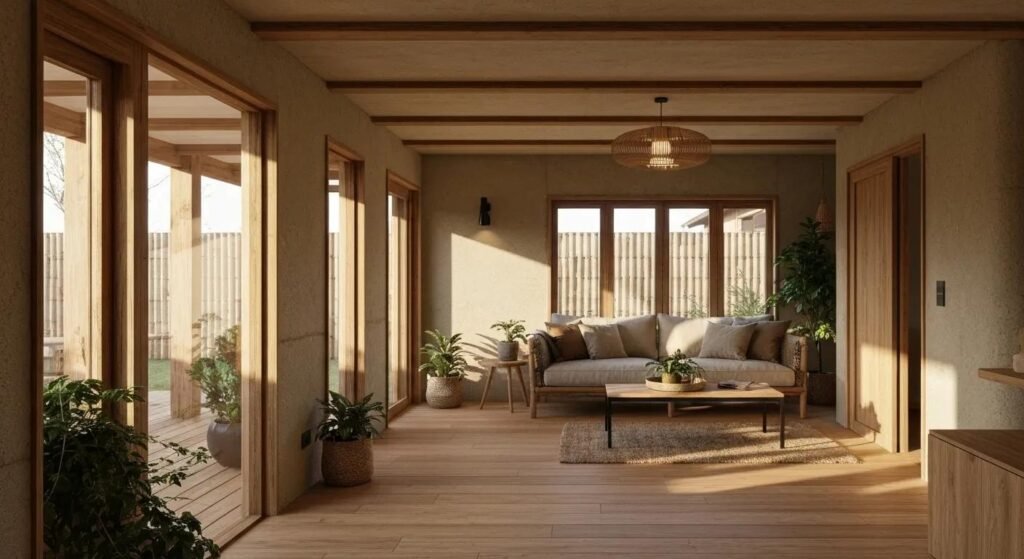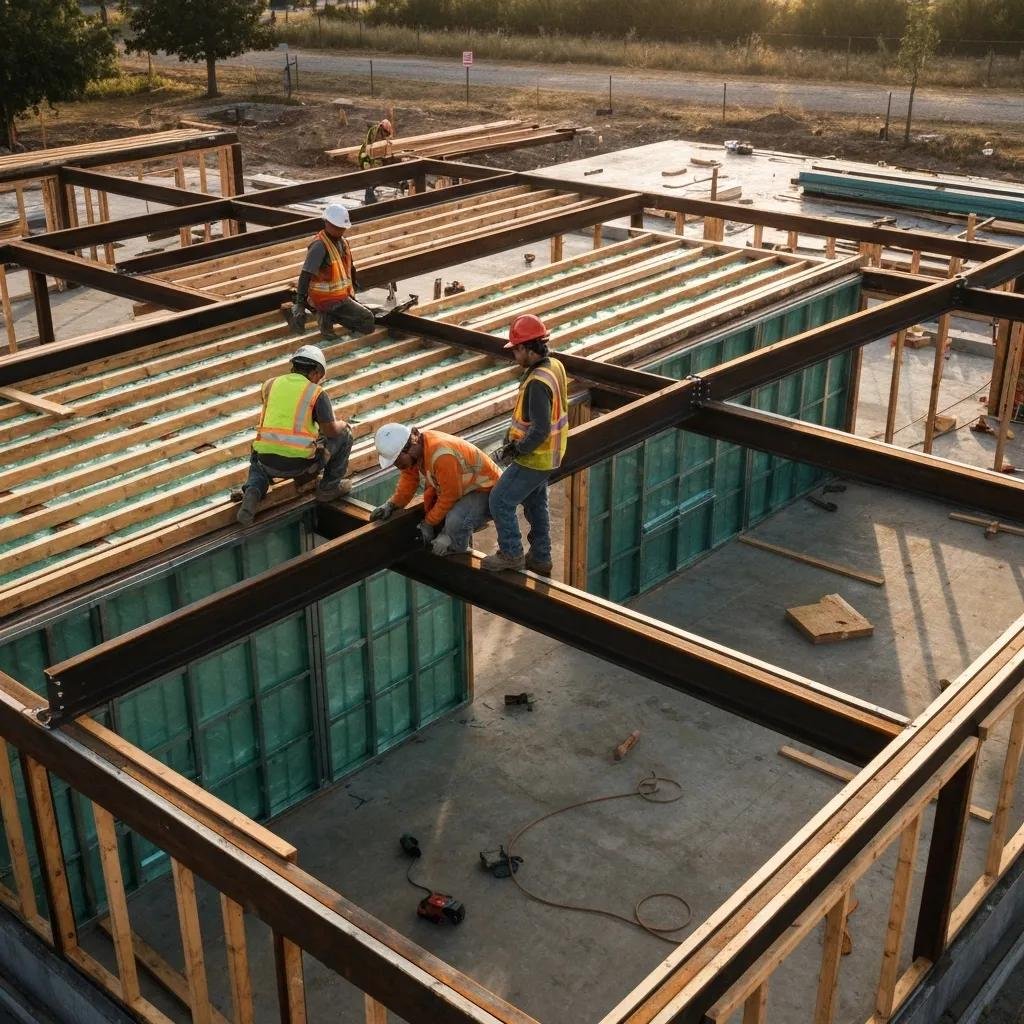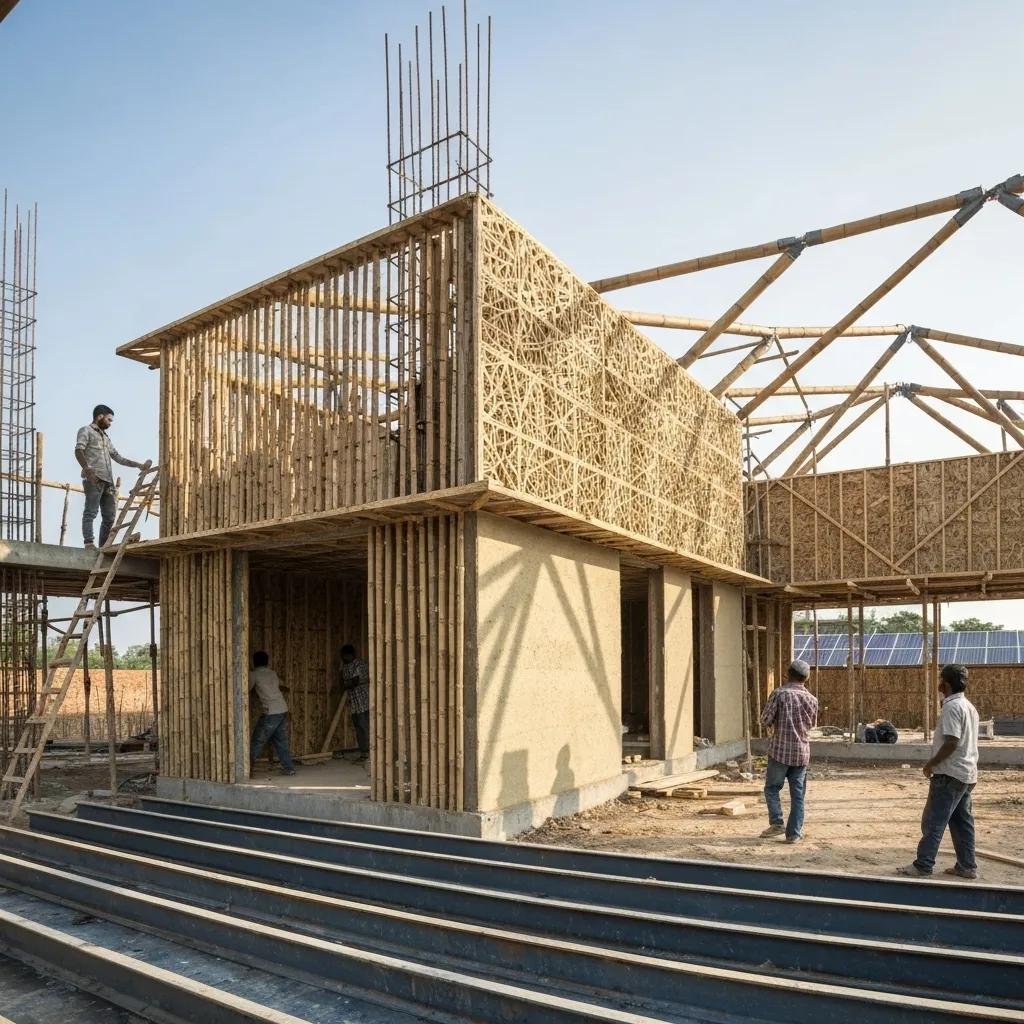Sustainable Building Materials for Eco-Friendly Construction
Alternative building materials represent a transformative approach to reducing embodied carbon and lifecycle waste in construction, offering eco-friendly benefits and resilient performance. This article explains why these materials matter, explores bio-based and recycled options, evaluates cost-effectiveness and long-term savings, reviews leading green certifications, highlights real-world case studies, and addresses common considerations for material selection. Businesses can also discover how maintaining indoor air quality with professional air duct and commercial cleaning services supports the health advantages of breathable wall systems. Readers will gain actionable insights on sourcing, performance attributes, and strategic implementation of alternative building materials.
What Are Alternative Building Materials and Why Are They Important for Sustainable Construction?
Alternative building materials are non-traditional resources—such as plant-based composites or reclaimed industrial byproducts—that reduce environmental impact by lowering embodied carbon, diverting waste, and promoting renewability. By replacing conventional cement, steel, or virgin timber, these materials support sustainable construction goals while enhancing energy efficiency and indoor comfort. Embracing alternative materials aligns with global decarbonization targets and sets the stage for advanced green building strategies.
How Do Alternative Building Materials Reduce Environmental Impact?
- They sequester carbon during growth or manufacturing, as hempcrete absorbs CO₂ in its hemp shiv.
- They divert waste streams; for example, recycled steel retains full tensile strength while avoiding landfill.
- They require less energy-intensive processing, reducing global warming potential compared to conventional concrete.
These effects combine to lower a building’s total carbon footprint and create healthier built environments that naturally extend into cleaner HVAC performance.
Which Key Properties Define Sustainable Building Materials?
- Thermal Performance: High R-value and thermal mass lower heating and cooling loads.
- Durability: Resistance to moisture, fire, pests, and UV preserves structural integrity.
- Renewability & Recyclability: Rapid regrowth or high recycled content ensures resource circularity.
- Indoor Air Quality: Low VOC emissions and hygroscopic regulation maintain healthy air.
These properties form the basis for predictable energy savings and occupant comfort in green construction projects.
What Role Do Certifications Like LEED Play in Material Selection?
LEED certification guides material selection by awarding credits for attributes such as recycled content, regional sourcing, and thermal performance. Projects earn innovation credits for using materials with documented environmental benefits, while MR (Materials & Resources) credits prioritize waste diversion and responsible supply chains. Aligning with LEED standards streamlines sustainable procurement and boosts market valuation.
What Are the Benefits and Applications of Bio-Based Materials in Construction?

Bio-based materials derive from renewable plant or animal sources, offering closed-loop lifecycles and carbon sequestration. Their natural composition enhances insulation, moisture regulation, and indoor air quality while reducing reliance on fossil-fuel-based products. Incorporating bio-based elements drives both ecological resilience and healthier interior environments.
What Is Hempcrete and What Are Its Construction Benefits?
Hempcrete is a bio-composite made from hemp hurd bonded with lime, delivering high thermal mass, moisture buffering, and carbon-negative credentials.
Sustainable Hempcrete Homes - in English
Hempcrete is a carbon-negative material — it continues to absorb carbon long after construction, storing more than what was emitted during construction. Hempcrete is an effective thermal insulator and performs well with temperature fluctuations.
Green City Times, Sustainable Hempcrete Homes,
| Material | Key Attribute | Performance Benefit |
|---|---|---|
| Hempcrete | Thermal Insulation | Provides high R-value and stabilizes indoor temperature |
| Hempcrete | Moisture Regulation | Buffers humidity and prevents mold growth |
| Hempcrete | Carbon Sequestration | Absorbs CO₂ both during hemp cultivation and lime curing |
Hempcrete’s lightweight nature reduces structural loads and pairs seamlessly with duct systems; professional air duct cleaning preserves its breathable wall performance by preventing dust buildup.
How Does Bamboo Serve as a Sustainable Structural Material?
Bamboo is a rapidly renewable grass with tensile strength comparable to steel and compressive strength similar to concrete. Properly treated bamboo resists pests and moisture, making it ideal for framing, flooring, and prefabricated panels. Its rapid growth cycle replenishes harvested stocks within a few years, ensuring a sustainable supply chain that supports low-impact construction.
The Best Sustainable Building Materials - in English
Bamboo is a fast-growing plant that can be harvested without killing it, making it a renewable resource and a highly sustainable option for construction. Bamboo has a high strength-to-weight ratio and exceptional durability.
Space Studies, Exploring Sustainable Building Materials: A Quick Guide,
This research supports the article’s claims about bamboo’s sustainability and its suitability for construction.
What Are the Thermal and Acoustic Advantages of Cork Insulation?
Cork board insulation leverages a closed-cell cellular structure to deliver exceptional acoustic dampening and thermal resistance. It naturally repels moisture and is fire-resistant, contributing to quieter, more comfortable indoor spaces. Cork panels are lightweight and easy to install, reducing labor costs and improving lifecycle performance in both residential and commercial projects.
Cork Insulation FAQs - in English
Cork has a thermal resistance of R-3.6 to R-4.2 per inch. Cork meets the European Class E designation for fire resistance.
ThermalCork Solutions, Cork Insulation FAQs,
This citation supports the article’s discussion of cork’s thermal and fire-resistant properties.
How Do Bio-Based Materials Contribute to Energy Efficiency and Indoor Air Quality?
Bio-based materials enhance energy efficiency by reducing thermal bridging and stabilizing indoor temperatures, cutting heating and cooling demands by up to 20 percent. Their natural breathability facilitates moisture exchange, preventing condensation and mold. Combined with routine air duct and commercial cleaning services, these materials sustain healthier airflows and maintain peak HVAC efficiency over time.
How Do Recycled and Upcycled Materials Enhance Durability and Sustainability in Construction?

Recycled and upcycled materials repurpose waste streams into high-performance building components, retaining structural properties while reducing landfill burdens and raw-material extraction. Their use supports a circular economy and often exceeds conventional durability standards.
What Are the Advantages of Using Recycled Steel in Sustainable Construction?
Recycled steel frames and reinforcement bars retain 100 percent of their original strength while saving up to 74 percent of the energy required for virgin steel production. Utilizing recycled steel reduces embodied carbon significantly and supports rapid construction schedules, thanks to standardized prefabrication and modular assemblies.
The Environmental Benefits of Using Recycled Steel in Construction - in English
Recycled steel has a smaller carbon footprint than virgin steel due to the energy savings in production and reduced need for raw materials. Utilizing recycled steel reduces embodied carbon significantly.
BuildSteel.org, The Environmental Benefits of Using Recycled Steel in Construction,
This research supports the article’s claims about the environmental benefits of using recycled steel in construction.
How Is Recycled Glass Used as Aggregate and Insulation in Building Projects?
Recycled glass cullet can replace fine aggregate in concrete or be processed into foam glass insulation panels.
| Material | Application | Key Benefit |
|---|---|---|
| Recycled Glass | Concrete Aggregate | Enhances pozzolanic reaction and diverts waste |
| Recycled Glass | Foam Glass Boards | Provides closed-cell insulation for walls and roofs |
These uses lower cement demand, divert urban waste, and deliver effective thermal and acoustic performance, supporting durable and sustainable building envelopes.
What Emerging Recycled Materials Are Innovating Construction Solutions?
Innovative recycled plastics and bio-polymers form interlocking building blocks and extrusion-based panels, offering lightweight, customizable modules. Composite lumber made from recycled wood and plastic delivers termite resistance and dimensional stability. As these materials evolve, they broaden low-impact design options and reduce reliance on virgin resources.
How Do Alternative Building Materials Impact Cost-Effectiveness and Long-Term Savings?
While some alternative materials carry higher upfront costs, their superior thermal performance, durability, and reduced maintenance create significant lifecycle savings. Lower operational energy, fewer repairs, and extended service life deliver strong return on investment for sustainable construction.
What Are the Energy Savings Associated with Hempcrete and Bamboo?
| Material | Energy Benefit | Mechanism |
|---|---|---|
| Hempcrete | Reduced heating/cooling loads | High thermal mass and insulating fibers |
| Bamboo | Lower embodied energy footprint | Low-energy cultivation and processing |
These savings decrease utility bills and support green building financial models by improving payback periods over conventional materials.
How Does Material Durability Reduce Maintenance Costs Over Time?
Materials such as treated bamboo resist pests and fungal decay, while recycled steel offers fire resistance and minimal corrosion when properly coated. Cork’s impermeable bark structure prevents moisture damage. These durability attributes reduce long-term repair needs and extend building lifespans.
Where Can Sustainable Materials Be Sourced Locally and Certified?
Regional suppliers of hempcrete, bamboo, and cork often carry certifications like FSC (Forest Stewardship Council) or Declare labels for low-emission products. Partnering with local producers cuts transport emissions and supports community economies. Engaging a commercial cleaning provider early ensures that installation debris and dust are managed efficiently to protect material integrity.
What Are the Leading Green Building Practices and Certifications Supporting Alternative Materials?
Green building practices establish guidelines and validation for sustainable design, empowering project teams to integrate alternative materials within recognized frameworks. Certifications communicate performance to stakeholders and unlock incentives.
How Does the US Green Building Council Promote Sustainable Construction?
The USGBC develops LEED standards, delivers education, and facilitates certification processes that reward innovation in material selection. Through LEED credits and pilot projects, USGBC drives market adoption of alternative materials and fosters continuous improvement of green building practices.
What Are the LEED Certification Requirements for Alternative Building Materials?
LEED v4 specifies credits for:
- Recycled Content – Points for materials with ≥25 percent recycled content.
- Regional Materials – Incentives for sourcing within 500 miles to reduce transport emissions.
- Innovation – Recognition for pioneering low-impact materials such as carbon-negative composites.
Meeting these requirements enhances a project’s environmental profile and market value.
LEED-Certified Materials for Sustainable Home Building - in English
LEED-certified materials are those that have been independently verified to meet specific sustainability standards set by the U.S. Green Building Council (USGBC). Recycled steel reduces embodied carbon by up to 74 percent compared to virgin steel and qualifies for LEED MR credits under both recycled content and regional material categories.
Rise, LEED for Homes 101: Materials & Resources,
This citation supports the article’s discussion of LEED certification and the benefits of using recycled steel.
How Do Carbon Neutral Construction Strategies Integrate Alternative Materials?
Carbon neutral projects combine material selection with on-site renewables, carbon offsets, and energy-efficient systems. Alternative materials like hempcrete and recycled steel supply embodied carbon reductions, while photovoltaic roofing and efficient HVAC further balance operational emissions.
What Case Studies Demonstrate Successful Use of Alternative Building Materials?
Examining real-world examples illustrates how alternative materials deliver measurable environmental and economic benefits while maintaining performance and aesthetics.
How Did the Eco-Home Project Reduce Energy Consumption Using Hempcrete and Recycled Steel?
The Eco-Home integrated hempcrete walls for high thermal mass and a recycled steel frame for structural support. This combination achieved a 40 percent reduction in annual energy use and a 30 percent decrease in embodied carbon, validating the material strategy for net-zero readiness.
What Are Examples of Bamboo Structural Applications in Earthquake-Resistant Buildings?
In seismic regions, engineered bamboo trusses and cross-laminated bamboo panels provide flexibility and energy dissipation. Projects in Southeast Asia demonstrate that bamboo framing outperforms traditional timber in lateral load resistance, supporting resilient and rapid-build methods.
Bamboo as a Construction Material in Earthquake-Prone Areas - in English
Bamboo’s flexibility and resilience can help reduce the impact of seismic activity on buildings, making it a sustainable and cost-effective solution for building structures. Bamboo matches or exceeds many hardwoods in tensile and compressive strength while regenerating far more quickly.
Base Bahay, Bamboo as a Construction Material in Earthquake-Prone Areas,
This citation supports the article’s discussion of bamboo’s strength and sustainability, particularly in the context of earthquake resistance.
How Have Cork and Recycled Glass Improved Insulation in Commercial Buildings?
Commercial façades employing cork panels benefit from enhanced acoustic isolation and moisture control, while recycled glass foam boards in curtain walls bolster thermal resistance. These installations report lower HVAC cycling and positive occupant feedback on noise reduction.
What Are Common Questions About Alternative Building Materials?
Professionals frequently inquire about material performance, sourcing, durability, and certification pathways when evaluating alternative building materials.
What Are the Most Sustainable Building Materials for Construction?
Materials such as hempcrete, bamboo, cork, recycled steel, and foam glass rank highly for sustainability because they combine renewable or recycled content with low embodied carbon and strong lifecycle performance.
Is Hempcrete a Good Building Material for Thermal and Moisture Regulation?
Yes. Hempcrete excels at stabilizing indoor humidity through its porous structure, and its high thermal mass reduces temperature swings, leading to consistent comfort and energy savings.
How Does Bamboo Compare to Traditional Wood in Strength and Sustainability?
Bamboo matches or exceeds many hardwoods in tensile and compressive strength while regenerating far more quickly. Its rapid growth cycle and minimal processing make it a more sustainable alternative to slow-growing timber.
What Is the R-Value of Cork Insulation and Its Fire Resistance?
Cork insulation delivers an R-value that rivals synthetic foams, and its natural fire-resistance properties meet stringent building codes without added chemicals, ensuring safety and thermal performance.
How Does Recycled Steel Contribute to LEED Certification and Carbon Footprint Reduction?
Recycled steel reduces embodied carbon by up to 74 percent compared to virgin steel and qualifies for LEED MR credits under both recycled content and regional material categories, supporting higher certification levels.
Alternative building materials unlock sustainability, performance, and economic benefits while fostering healthier indoor environments. By integrating these materials with certified green building practices and ensuring ongoing indoor air quality through professional air duct and commercial cleaning services, project teams can deliver resilient, energy-efficient structures that meet modern environmental and occupant demands. Businesses seeking to combine eco-innovation with operational excellence are encouraged to explore these solutions and partner with specialized cleaning providers to maintain peak building performance.





